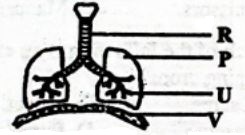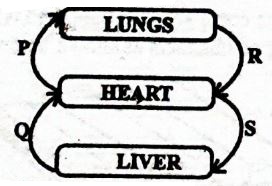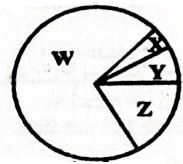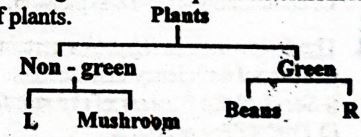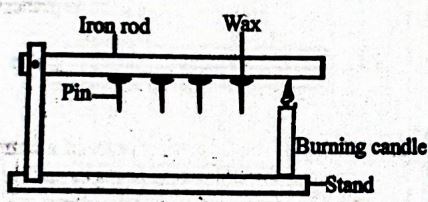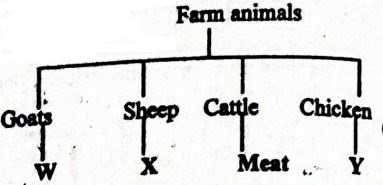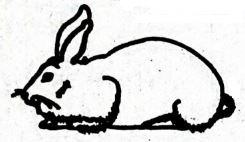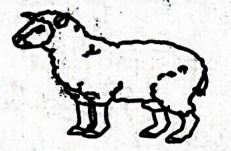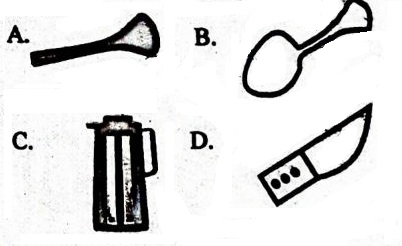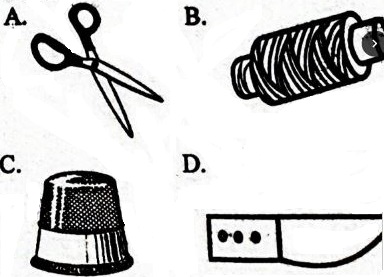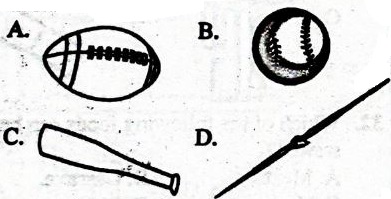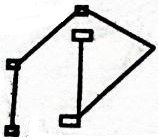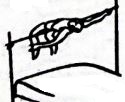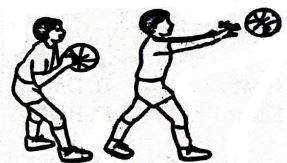Questions
Science And Technology
- Grade 6 learners at Maseno academy carried out an experiment like the one shown below,
Which property of matter were they investigating?- Effects of hot and cold water on patter.
- Expansion and contraction of solids.
- Expansion and contraction of gases,
- Expansion and contraction of liquids
- Use the diagram below to answer the following question,
Which statement does not match with the parts represented by letters in the diagram above?- P- its volume decreases during exhalation.
- U - cleans and warms the air.
- R - helps the trachea to stay open.
- V - flattens during inhalation.
- Below is a simplified diagram of the circulatory system.
Which pair of blood vessels carry blood with carbondioxide?- P, Q
- P, S
- R, S
- P,R
- The pie chart below shows the composition of gases that make up air.
Which of the following statements is true about the composition of air represented above?- The gas marked W is used during germination.
- Gas X can be used to put out fire.
- The gas labelled Y is used to preserve soft drinks.
- Gas Z is used by legumes to make proteins.
- Which of the following parts of a computer displays the document being typed?
- Keyboard.
- Monitor.
- Printer.
- Mouse.
- The diagram below represents classification of plants.
Which of the following plants can be used to represent L and R respectively?- Mucor, bracket tree.
- Moss, grass.
- Cabbage, toadstool.
- Moulds, sugarcane.
- Which of the following statements is true?
- A VDU is used to process data.
- A mouse has a space bar.
- A cursor shows the end of text being worked on.
- The monitor is used to produce hard copies.
- Which of the following small animals are all invertebrates?
- Newt, cockroach, spider.
- Snail, spider, mite.
- Slug, crab, frog.
- Centipede, snake, scorpion.
- Which of the following effects of heat on matter are as a result of increase in temperature?
- Melting and expansion.
- Condensation and contraction.
- Freezing and evaporation.
- Evaporation and contraction.
- Which of the following is not a fimction of leaves?
- Photosynthesis.
- Breathing.
- Transpiration.
- Absorption.
- The diagram below shows transfer of heat on matter.
The type of heat transfer demonstrated above is called- convection.
- radiation
- conduction.
- expansion
- The following are signs of a certain nutritional deficiency disease:
- Sores at the corners of the mouth.
- Protruding stomach
- Swollen body parts.
- Brown hair.
Which of the following foods can be recommended for a person suffering from the disease?- Beans, tomatoes, cabbages.
- Rice, ugali, liver.
- Meat, fish, groundnuts.
- Chips, sugarcane, bananas.
- Candle wax is able to float on water because of its
- weight.
- material.
- size.
- shape.
- Crops such as peas, greengrams and are called
- cereals.
- legumes.
- tubers.
- vegetables.
- Below is a chart showing farm animals and their uses:
Which products are represented by W, X and Y respectively?- Milk, mutton, eggs. :
- Wool, mutton, eggs.
- Mutton, meat, mohair.
- Hide, eggs, meat.
Agriculture
- Which of the following is not a planting material for creeping crops?
- Seeds.
- Hoes.
- Scissors.
- Manure. Burning candle
- Which of the following is an example of creeping crops?
- Cactus.
- Carrot.
- Passion.
- Pumpkin.
- Which of the following is a deterrent of wild animals against farming activities?
- Scarecrow.
- Chicken.
- Mongoose.
- Bananas.
- All the following are ways of conserving water in the farm except
- mulching.
- shading.
- thinning.
- cover cropping.
- Kwame came across a bare land with deep U-shaped channels as shown below
.
Which type of soil erosion was this likely to be?- Splash erosion.
- Rill erosion.
- Sheet erosion.
- Gulley erosion.
- Exposed plant roots on a bare flat ground is an indication of
- Splash erosion.
- sheet erosion.
- gulley erosion.
- rill erosion.
- All the following are ways of controlling soil erosion. Which one is not?
- Using drip irrigation.
- Mulching.
- Planting cover crops
- Building gabions.
- Below is a small domestic animal reared in Kenya.
Which of the following are the products from the animal above?- Meat and milk.
- Manure and meat.
- Milk and skin.
- Wool and manure.
- Identify the animal drawn below.
- Goat.
- Dog
- Sheep.
- Bull.
- Which of the following shows a pair of tiny seeded crops?
- Sugarcane and banana.
- Onions and tomatoes.
- Pumpkin and cucumber.
- Sunflower and carrots.
Homescience
- Which of the following lists consists of accessories only?
- Lipstick, eye pencil, deodorants.
- Deodorants, creams, nailpolish.
- Perfumes, headgears, lotion.
- Scarves, necklaces, wristbands.
- A person between 13 and 19 years is
- a young man.
- an underage.
- a small lady.
- an adolescent.
- Which of the following diseases is non- communicable?
- Tuberculosis.
- Malaria.
- Epilepsy.
- Covid-19.
- Which of the following is not a factor to consider when making a budget?
- Taste and preference.
- Amount of money.
- The type of food.
- The weather of the day.
- A sufuria is a cooking equipment that is commonly cleaned using
- Charcoal powder.
- steelwool.
- a sand paper.
- egg shells.
- Which of the following is a fragile kitchen utensil?
- Which of the following foods can be stewed?
- Meat
- Cassava
- Yams.
- Cabbage.
- Which of the following may be needed for baking?
- Maize flour.
- Oven.
- Onions.
- Tomatoes.
- Which of the following is not a needle work tool?
- Which or the following lists consists of a balanced diet?
- Rice, meat, chapati.
- Fish, orange, carrots.
- Ugali, eggs, kales.
- Chips, sausages, chicken.
Physical Health Education.
- 'Which one of the following is not a track event?
- Back stroke.
- Bunch start.
- Shoulder shrug
- Drop finish.
- Partner work can be applied in
- swimming.
- football.
- athletics.
- ropework.
- Which of the following is not a rope work technique?
- Wounded duck.
- Pivoting.
- Skier.
- Heel taps.
- Which of the following equipment is used in standing javelin?
- Scissor technique can be applied in
- high jump.
- soccer.
- kabaddi.
- softball.
- Which of the following is the first phase in high jump?
- Landing.
- Take off
- The run.
- Flight
- A teacher drew a diagram like the one drawn below.
What did the teacher draw?- shotput sector.
- rounders pitch.
- javelin sector.
- volleyball pitch.
- Study the picture below.
The item drawn above can be used when practising- football.
- high jump.
- handball.
- volleyball.
- When practising tapping in soccer, we can use our
- heads.
- hands.
- elbows .
- highs.
- How many players make up one kabaddi team?
- 7
- 11
- 12
- 6
- A group of learners was seen practising single hand dig pass. Which game were they preparing for?
- Handball.
- Volleyball.
- Football.
- Basketball.
- Study the type of pass below.
The type of pass above is called- bounce pass.
- chest pass.
- dig pass.
- instep pass.
- Which of the following can be used to improvise a relay baton?
- Broken glasses.
- Maize stalks.
- Old clothes.
- Thread.
- Smitts are worn to protect our
- hands
- eyes
- knees.
- elbows.
- Which of the following is not a pool activity?
- Crouch surface dive.
- Backstroke
- Standing surface dive.
- Punting.
Marking Scheme
| Science aad Technology | Agriculture | Home Science | Physical Education | ||
|
|
|
|
|
|
Join our whatsapp group for latest updates
Tap Here to Download for 30/-
Get on WhatsApp for 30/-
Download Integrated Science Questions and Answers - CBC Grade 6 KPSEA End Term 3 Exam 2022 Set 1.
Tap Here to Download for 30/-
Get on WhatsApp for 30/-
Why download?
- ✔ To read offline at any time.
- ✔ To Print at your convenience
- ✔ Share Easily with Friends / Students


